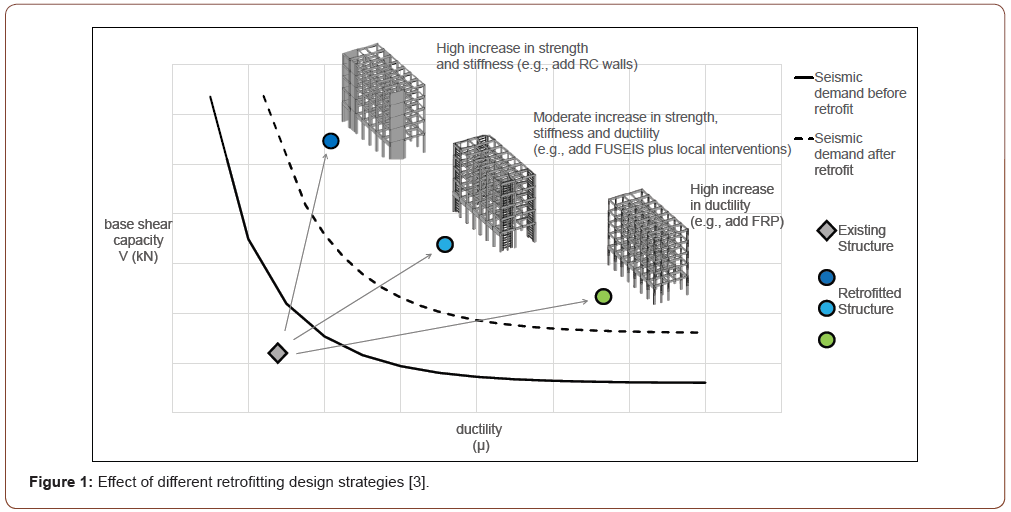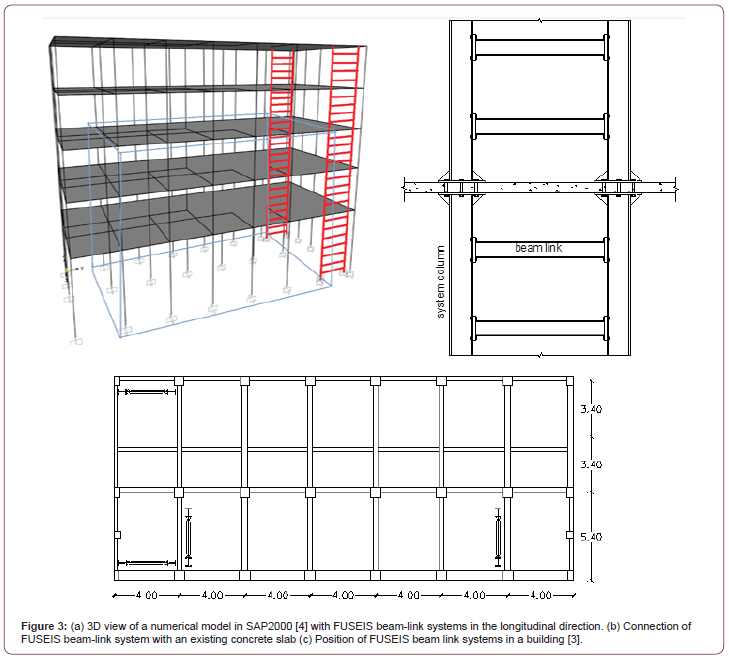 Mini Review
Mini Review
Rehabilitation of Existing Buildings Using Fuseis Beam-Link Systems
P Tsarpalis*, I Vayas, P Thanopoulos and D Vamvatsikos
School of Civil Engineering, National Technical University of Athens, Athens, Greece
P Tsarpalis, School of Civil Engineering, National Technical University of Athens, Athens, Greece.
Received Date: November 24, 2021; Published Date: December 03, 2021
Abstract
During the past few decades, with the introduction of modern seismic provisions and the availability of advanced materials several seismic retrofit techniques have been de-veloped. FUSEIS beam-link is a steel lateral-load resisting system, which comprises stiff-ness, ductility, easy replaceability and architectural versatility, making it a suitable choice for strengthening existing reinforced-concrete buildings. A case study is presented, where a deficient structure is upgraded by introducing FUSEIS beam-link systems, first by performing response spectra analysis, then refining the results via non-linear static analysis.
Keywords: Innovative anti-seismic systems; Rehabilitation; Behaviour factor; Seismic performance; Steel structures; Eurocodes; FUSEIS; Retrofit
Introduction
The majority of existing buildings in Europe (at least before
1980) are reinforced concrete (RC), designed and constructed in
accordance with old regulations that did not mandate adequate detailing
and reinforcement for seismic protection. A large number of
these buildings have already suffered damage since their erection
due to earthquake activity or other natural hazards, while the rest
have high probability of collapsing in the future. In general methods
that have been developed to seismic strengthening such buildings,
can be classified according to the following scheme:
• Methods to repair/upgrade existing structural elements,
are based on the idea of increasing the deformation capacity of
existing members (i.e., epoxy injections, steel or concrete jacketing,
the use of fibre-reinforced polymers (FRP) etc).
• Methods to add new structural elements that typically
increase both its strength and stiff-ness, are based on the idea
of reducing deformation demand of the existing structure (i.e.,
new steel seismic resistant systems, usually X-braces).
Steel systems are very affordable and easy to be placed, but they rely on steel yielding for energy dissipation, hence need to be repaired after the earthquake. Repairing works can be too difficult or too expensive to implement, requiring large steel members to be replaced and temporary or permanent closure of the building, leading to economic loss. This drawback can be solved by means of innovative easy-replaceable steel systems such as INERD pin connection, FUSEIS beam and pin link systems [1,2].
As the following graph of Figure 1 illustrates, an efficient selection of the retrofitting strategies can be done, by first defining the structural weaknesses and then choosing the target performance level. For example, if we aim to reduce seismic demand on the existing structure by greatly increasing strength-stiffness at loss of ductility, adding RC walls or steel X-braces may be more appropriate. On the contrary if we aim in improving the capacity of the existing elements by increasing their ductility, local interventions like FRPs may be used. Finally, moderate improvements in both stiffness, strength and ductility may be sought by adding relatively flexible steel systems such as FUSEIS beam-link system.
Seismic Retrofit Using Fuseis Beam-Link System
The FUSEIS beam-link system [2] is composed of two closely- spaced strong columns, rigidly connected by multiple horizontal beams. The beams can be of square hollow section (SHS), circular hollow section (CHS) or I/H-shaped (e.g., IPE or HEA) sections. The general layout of the system is given in Figure 2. In order to protect the column and the beam-to-column connection against yielding and early fracture, reduced beam sections (RBSs) are foreseen at the ends of the beams. After a strong earthquake, inelastic deformations will only occur in the RBS of the dissipative beam link elements, which can be easily replaced.


FUSEIS systems may be used as strengthening method in existing RC buildings that do not comply with modern seismic regulations. They are a cost-effective solution in cases where the old structure possesses enough ductility so that it can reach its performance targets with a moderate increase in stiffness and strength, perhaps coupled with some local interventions in critical elements. A proposed connection approach with the RC members is by connecting the FUSEIS columns to the concrete slab. This type of connection ensures the transfer of the internal forces of the upper FUSEIS column to the lower one without imposing excessive stress to the existing concrete slab. Local reinforcement of the slab may also be needed, to ensure that the diaphragm forces will be transferred to the FUSEIS system. The design of the rehabilitation can be performed by modal response spectrum analysis using a proposed behaviour factor value of 4.0 [3] or by upgrading the model to include the response of structural members beyond the elastic zona and perform a pushover analysis (Figure 3).

Conclusion
The FUSEIS beam-link system may be used successfully for rehabilitation of existing structures, leading to smart and efficient solutions in terms of architectural interventions, while significantly improving the structural behaviour of the structure. Following the proposed methodology, the design may be carried out by modal response spectrum analysis or pushover analysis.
Acknowledgement
The authors acknowledge the support of the European Commission through the Research Fund for Coal and Steel (RFCS) Grant Agreement Number 709434 [5].
Conflict of Interest
No conflict of interest.
References
- Plumier A, Doneux C, Castiglioni C, Brescianini J, Crespi A, et al. (2006) Two Innovations for Earth-quake Resistant Design. The INERD Project, Report EUR22044EN.
- I Vayas, Ph Karydakis, D Dimakogianni, G Dougka, Calado L, et al. (2012) Dis-sipative devices for seismic resistant steel frames. The FUSEIS project.
- P Tsarpalis, I Vayas, P Thanopoulos, D Vamvatsikos (2021) Rehabilitation of rein-forced concrete building using the FUSEIS beam-link system. Structures 34: 3300-3314.
- SAP (2000) CSI, Computers and Structures Inc.
- INNOSEIS consortium (2017) Project website.
-
P Tsarpalis, I Vayas, P Thanopoulos, D Vamvatsikos. Rehabilitation of Existing Buildings Using Fuseis Beam-Link Systems. Glob J Eng Sci. 9(1): 2021. GJES.MS.ID.000702.
-
Poverty alleviation, National student source credit student loan policy, Poverty alleviation without returning to poverty, Rural revitalization
-

This work is licensed under a Creative Commons Attribution-NonCommercial 4.0 International License.






